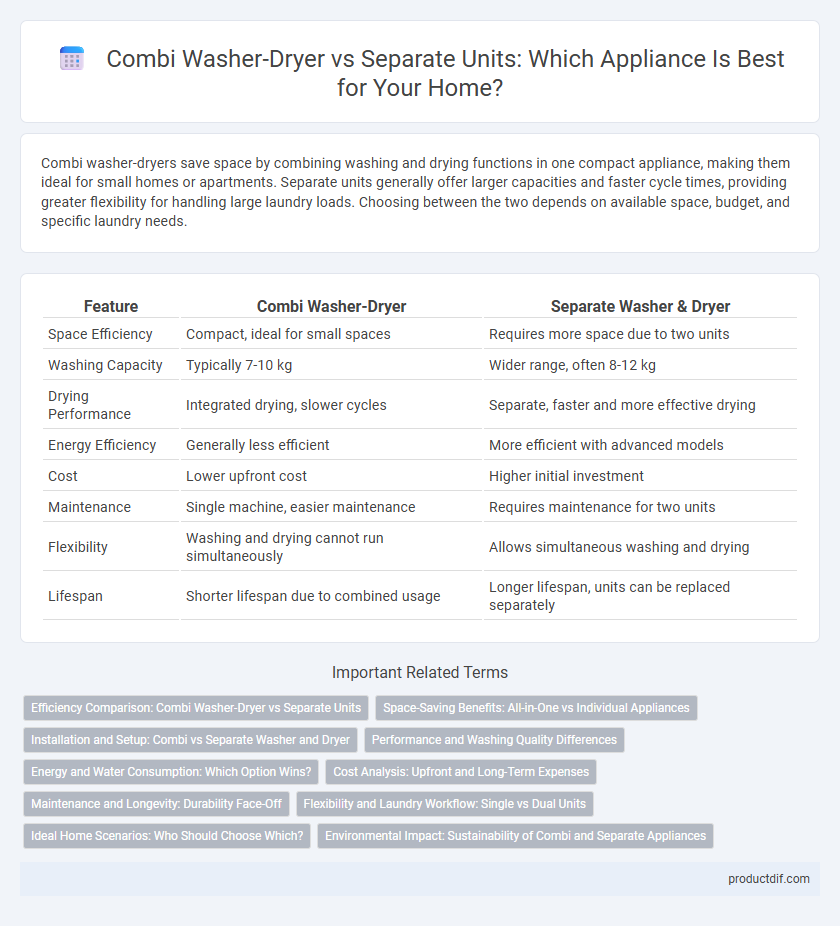Combi washer-dryers save space by combining washing and drying functions in one compact appliance, making them ideal for small homes or apartments. Separate units generally offer larger capacities and faster cycle times, providing greater flexibility for handling large laundry loads. Choosing between the two depends on available space, budget, and specific laundry needs.
Table of Comparison
| Feature | Combi Washer-Dryer | Separate Washer & Dryer |
|---|---|---|
| Space Efficiency | Compact, ideal for small spaces | Requires more space due to two units |
| Washing Capacity | Typically 7-10 kg | Wider range, often 8-12 kg |
| Drying Performance | Integrated drying, slower cycles | Separate, faster and more effective drying |
| Energy Efficiency | Generally less efficient | More efficient with advanced models |
| Cost | Lower upfront cost | Higher initial investment |
| Maintenance | Single machine, easier maintenance | Requires maintenance for two units |
| Flexibility | Washing and drying cannot run simultaneously | Allows simultaneous washing and drying |
| Lifespan | Shorter lifespan due to combined usage | Longer lifespan, units can be replaced separately |
Efficiency Comparison: Combi Washer-Dryer vs Separate Units
Combi washer-dryers offer space-saving convenience but generally consume more water and energy per cycle compared to separate units, which are optimized individually for washing and drying efficiency. Separate washer and dryer units typically provide faster cycle times and better performance, reducing overall energy consumption and drying time. Choosing separate units can lead to improved efficiency and cost savings in the long run, especially for larger households with frequent laundry loads.
Space-Saving Benefits: All-in-One vs Individual Appliances
Combi washer-dryers offer significant space-saving benefits by combining washing and drying functions into a single unit, ideal for small apartments or homes with limited laundry space. Separate units often require more room for placement and installation, making them less suitable for compact living environments. Choosing an all-in-one appliance maximizes utility without sacrificing performance, providing efficient laundry solutions within a minimal footprint.
Installation and Setup: Combi vs Separate Washer and Dryer
Combi washer-dryers simplify installation by requiring only one water and electrical connection point, saving space and reducing setup time compared to separate washer and dryer units that need individual hookups. Separate units offer flexible placement options but demand more extensive plumbing and electrical work, often increasing installation costs. Choosing a combi unit is ideal for compact spaces, while separate appliances suit larger laundry areas with dedicated hookups.
Performance and Washing Quality Differences
Combi washer-dryer units offer convenient space-saving designs but typically deliver lower washing and drying performance compared to separate machines, which are optimized for each function. Separate units provide superior cleaning quality and faster drying times due to specialized components and larger drum capacities. Performance metrics like energy efficiency, spin speed, and wash cycle variety tend to be higher in individual washers and dryers, resulting in better fabric care and overall laundry outcomes.
Energy and Water Consumption: Which Option Wins?
Combi washer-dryers generally consume less water and energy per cycle compared to using separate washer and dryer units due to their combined functionality and optimized usage patterns. Energy Star-rated combi units often achieve up to 30% lower electricity consumption by recycling heat and using advanced moisture sensors, reducing drying times. Separate washers and dryers tend to use more water and energy overall since they operate independently, making combi models the more efficient choice for energy and water conservation.
Cost Analysis: Upfront and Long-Term Expenses
Combi washer-dryers typically have a lower upfront cost compared to purchasing separate washer and dryer units, making them an attractive option for budget-conscious consumers. However, separate units often provide better energy efficiency and longer lifespan, which can result in lower long-term operating expenses and maintenance costs. Evaluating electricity usage, repair frequency, and replacement timelines is crucial for an accurate cost analysis between combi units and individual appliances.
Maintenance and Longevity: Durability Face-Off
Combi washer-dryers often require more frequent maintenance due to their complex integrated design, which can lead to higher repair costs over time. Separate washer and dryer units, while occupying more space, typically offer greater durability and easier servicing since each appliance operates independently. Investing in separate units can extend overall appliance lifespan and minimize downtime caused by maintenance issues.
Flexibility and Laundry Workflow: Single vs Dual Units
Combi washer-dryers offer compact design and space-saving benefits by combining washing and drying functions in one appliance, ideal for limited living spaces. Separate washer and dryer units provide greater flexibility and efficiency, allowing simultaneous washing and drying cycles, which significantly speeds up the laundry workflow. Dual units also enable users to select specific settings tailored to each cycle, improving overall fabric care and customization.
Ideal Home Scenarios: Who Should Choose Which?
Combi washer-dryers are ideal for small apartments or homes with limited space, offering the convenience of washing and drying in a single machine. Separate washer and dryer units suit larger households or those with high laundry volumes, providing faster cycle times and the ability to wash and dry simultaneously. Choosing between them depends on space availability, laundry frequency, and the need for efficiency versus convenience.
Environmental Impact: Sustainability of Combi and Separate Appliances
Combi washer-dryers typically consume less water and energy overall compared to separate washer and dryer units, resulting in a smaller environmental footprint. Separate appliances, while often more efficient in their specific tasks, tend to use more total resources due to dual operation and increased space requirements. Choosing combi units can reduce carbon emissions by consolidating cycle times and optimizing water usage, promoting greater sustainability in appliance usage.
Combi washer-dryer vs Separate units Infographic

 productdif.com
productdif.com